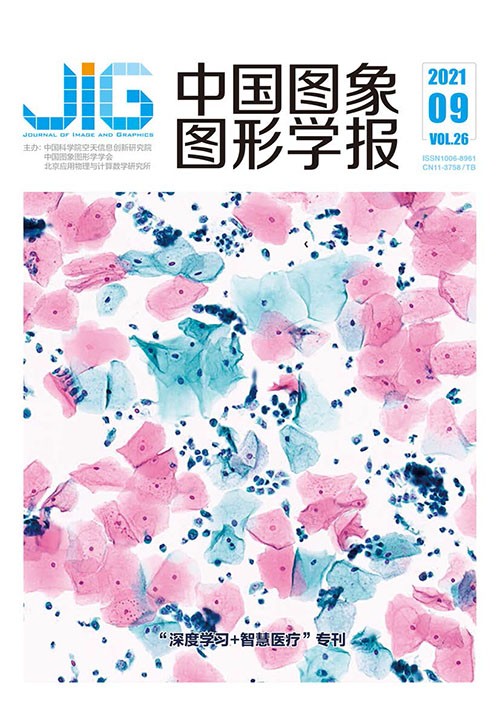
融合注意力机制和特征金字塔网络的CT图像肺结节检测
张福玲1, 张少敏1,2,3, 支力佳1,2,3, 周涛1,3(1.北方民族大学计算机科学与工程学院, 银川 750021;2.宁夏回族自治区人民医院医学影像中心, 银川 750000;3.北方民族大学图像图形智能处理国家民委重点实验室, 银川 750021) 摘 要
目的 针对现有肺结节检测算法存在的因肺部计算机断层扫描(computed tomography,CT)图像肺结节与周边组织复杂性导致结节本身结构差异性不明显的问题,以及特征提取网络多次下采样造成图像分辨率降低进而导致检测结果差、仅使用网络顶层特征图进行预测造成图像空间信息丢失进而导致小结节漏检等问题,提出了一种基于注意力机制和特征金字塔的肺结节检测算法。方法 根据语义与空间特征补偿机制以及卷积神经网络中网络深度所提取特征的信息量不同,在以ResNet为骨干网络的特征提取网络中设计通道—空间注意力机制,尽可能同时获取含有较多上下文语义以及空间位置信息的特征信息。在网络预测部分设计特征金字塔网络,将高维带有丰富语义信息的特征图与低维带有位置信息的特征图融合进行多尺度预测,增强网络对于小结节以及近血管结节等非显著性目标的检测性能。结果 在LUNA16(lung nodule analysis 16)数据集上进行十折交叉验证显示,当平均假阳性个数为25.99时敏感度达到了97.13%,与基准方法相比,敏感度提高了2.53%,平均假阳性降低了28.54,实现了高敏感度低假阳性;在0.125、0.25、0.5、1、2、4、8这7个假阳率点的敏感度平均值为0.854,其中在每个扫描4次和8次假阳性时敏感度分别达到了0.940和0.951,其效果优于主流的结节检测方法。结论 提出的结节检测模型,可以提高对3~10 mm小结节、近血管结节等非显著性目标的检测性能,并具有较低的假阳率。
关键词
Detection of pulmonary nodules in CT images by combining an attention mechanism and a feature pyramid network
Zhang Fuling1, Zhang Shaomin1,2,3, Zhi Lijia1,2,3, Zhou Tao1,3(1.School of Computer Science and Engineering, North Minzu University, Yinchuan 750021, China;2.Medical Imaging Center, Ningxia Hui Autonomous Region People's Hospital, Yinchuan 750000, China;3.The Key Laboratory of Images & Graphics Intelligent Processing of State Ethnic Affairs Commission, North Minzu University, Yinchuan 750021, China) Abstract
Objective The different structure of the nodules have not been clear in terms of the lung computer tomography (CT) images interpretation level for lung nodules and surrounding tissues. The detected image resolution has been reduced due to multiple downsampling of the feature extraction network. The feature map of the network top-layer has been predicted to the losses of spatial information and missing nodules. A algorithm called attention_FPN_RPN(attention_feature pyramid networks-region proposal network) for lung nodule detection have been demonstrated via attention mechanism and feature pyramid network. Method The detection performance has been improved for an end-to-end lung nodule detection model training via integrating nodule candidate detection and false positive reduction into a model for joint training. At the beginning, the lung parenchyma has been segmented to form the image dataset for training and testing via threshold and morphology. The designated nodule detection model has been based on the region proposal network (RPN) of the faster R-CNN(region convolutional neural network) network. The network model has been illustrated based on the U-Net network structure using low-dose chest CT thin-slice plain scan images as input and outputs candidate nodules position and probability information. Next, the channel-spatial attention mechanism in multi-layers network has been designed in the feature extraction network via the backbone network-ResNet in terms of the semantic and spatial feature compensation mechanism and the amount of extracted feature information. Multi-layers features have been refined to retain feature information each. The integration of lower and higher dimensional features have been spatially interpreted to obtain feature information with more contextual semantics and spatial location information. The semantic information has been qualified via the top-layer of feature map for prediction though the losses of spatial information extracted. The 3D spatial information in CT sequence has not been be fully utilized. The feature pyramid network has been fused high-dimensional feature maps via rich semantic information and low-dimensional feature maps with location information. Multi-scale information network-based detection for insignificant targets like small nodules and proximal vascular nodules has been enhanced. Data enhancement and hard negative data mining has been adopted to optimize the dataset. The sliding window analysis has been used to crop 208×208×208 patch in the preprocessed CT image-based lung parenchymal area. The step size has been consistent with the size of the nodule probability map based on network analysis. Based on convolution calculation, an overlap of 32 pixels amongst the divided blocks have been cropped to eliminate the undesired boundary. At the end, the probability map of the obtained small image block has been refilled into the CT image space to obtain the final probability based on the same size of the graph and the input CT image. Each voxel in the probability graph has illustrated the intended area of lung nodule. For the output result of each small block, the 100 nodules with the highest probability have been retained. Based on summing all patches to obtain candidate nodules, the candidate nodules with high overlap have merged via non-maximum suppression (NMS) method with a threshold of 0.5 for each image. The nodule based on the highest probability has been opted for each group of candidate nodules in the context of a high degree of overlap. Result 10-fold cross-validation on the lung nodule analysis 16(LUNA16) dataset has shown that the sensitivity of the proposed model can be reached 97.13% under the average of 25.99 false positives per scan. In the benchmark, the sensitivity has been increased by 2.53%. The false positive average value has been reduced simultaneously to achieve high sensitivity low false positive, the average sensitivity value of the seven false positive rate points has acquired 0.125, 0.25, 0.5, 1, 2, 4, and 8 respectively. The sensitivity of the proposed model has reached 0. 940 and 0.951 respectively under the average of 4, 8 false positives per scan, which is better than mainstream nodule detection methods. Conclusion In the context of fewer false positives, the demonstrated nodule detection model has improved the detection results of insignificant targets like 3~10 mm small nodules and proximal vessel nodules based on non-false positive reduction measures. A precise detection for tiny lung nodules has prior to the existing pulmonary nodule detection. The setup of an automatic screening system for small lung nodules and a clinical auxiliary diagnosis system for lung nodules have been benefited from the research.
Keywords
pulmonary nodule detection attention mechanism feature pyramid network(FPN) insignificant target detection 10-fold cross-validation
|



 中国图象图形学报 │ 京ICP备05080539号-4 │ 本系统由
中国图象图形学报 │ 京ICP备05080539号-4 │ 本系统由